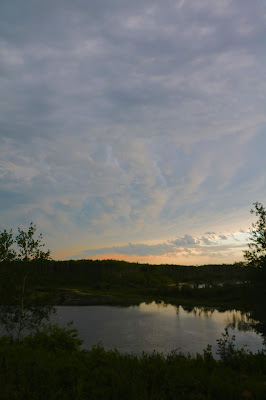
When I started this blog my intention was to display my photographs, provide quotes, especially from poetry and note some of my observations, mainly of nature or the weather. The latter seems to have generally fallen by the wayside and I have been content to pair a photograph with a quote I think is appropriate and call it a day. But it was occurred to me that, especially now at the cabin that the opportunity for observations of nature will never be better. So let’s meet the neighbours. The Franklin’s Ground Squirrels first appeared in the meadow in front of the cabin in 2017. One nice thing about maintaining this blog is that if I record things promptly I can jog my memory as far as dates go. Originally there were one or two (looks like two). In the summer of 2018 we noticed the first young ones playing by the car. The other evening I was standing on the porch and noticed five by one bird feeder and five by the other, so we now have at least 10 but I suspect that estimate in low. Our reference books mention that their behaviour is complex and changeable. They are often considered the least social of ground squirrels but will form colonies where there is abundant food. (here) As they live in brushy areas they can be hard to see but habituate to humans easily. (here). They can climb trees.




Our observations follow. They habituated easily with no help from us except that we did not actively chase or discourage them. Their holes are maybe 10 feet from the cabin steps, they ignore the frantic dogs barking from the run or even going by on leashes. Their alarm call is more likely to be used for air-borne predators (in one case a raven) than anything we seem to do, But they will call if you walk directly up to them while they are peering from their hole (a guest). We have never seen them climb. (Correction July 20th, 9:45 one of the medium sized Franklin's tried to climb a 2.5 foot Saskatoon, it got about half way up when the plant bent under the weight.) The young are, initally like kids anywhere.
The books mention that the female has one litter a year and that normally the young females do not breed their first year. They do eat a fair bit of protein, one book calls them weasel-like. They will eat small animals mice, young birds, other ground squirrels up to rabbits and ducks. They often eat duck eggs and hunting groups have tried to eradicate them in many areas because of this. We have deliberately left the meadow in front of the cabin alone except for a few paths we use where the grass is cut because of ticks. At present the Franklin’s share this area with Least Chipmunks. Red Squirrels and an ever increasing number of Snowshoe Hares. The Hares and Franklin’s seem to ignore each other. I have even seen the Chipmunks within five feet of the Franklin’s but they also dash through the dog run when the dogs are in it so I guess they are counting on speed.


We do get occasional bird strikes against cabin, I try to move them to a safe area to see if they recover. Two woodpeckers did but a Pine Siskin did not. I was holding it on the porch when I noticed a Franklin’s. I tossed it about a foot to one side, expecting it to at least pull back at the unexpected action. Instead it jumped on the bird in a flash, carried it a foot or so away turned its back and began eating. A dead mouse (they try to move into our car air filter) was tossed to another, it moved away a few inches then sniffed it. It did not take the mouse, but one five feet away was eyeing it when a third appeared sniffed it and carried it off. (Pls note I will not continue actively feeding them, that experiment is over) Two things are apparent they are not afraid of me tossing things towards them and they react to small animals as food quite readily. The birds spill a lot of sunflower seeds from the feeders, so they are quite well feed but they also are eating an enormous amount of plant material from the meadow. We do seem to have young ducks on the slough so perhaps ours are well feed enough that they don’t move that far for food. I am sure any ground nesting birds will have to move further from the cabin, but we suspect the Red Squirrels have been the main predators of birds around the cabin so far.

We have never had this many hares so the Franklin’s presence has as yet
not discouraged them. The Red Squirrels still come to the feeder and spend a lot of time there so the presence of the Franklin’s does not seem to discourage them either. One evening I stepped out on the porch. A Red Sqirrel was sitting on the step watching a young hare and four Franklins all feeding between the porch and the car.
"Much is missed if we have eyes only for the bright colors. Nature should be viewed without distinction... She makes no choice herself; everything that happens has equal significance. Nothing can be dispensed with. This is a common mistake that many people make: They think that half of nature can be destroyed - the uncomfortable half - while still retaining the acceptable and the pleasing side."
Eliot Porter
Books:
Mammals of Alberta, Pattie & Fisher
The Natural History of Canadian Mammals, Donna Naughton

















































